
We need a solids removal unit, for our diamond drilling projects, it moves often, and as you know it is a small rig. Since GN has designed solids removal units which can be loaded by helicopter, we know exactly what this means to the diamond drilling projects. Far away from the downtown, and live with animals, can’t find live people living there.
For these two systems to South America, glad that they do not need load by helicopter. Then all we need to do is:
1) All equipment in this unit for solids removal
2) Keep it compact, flexible, easy for transportation.
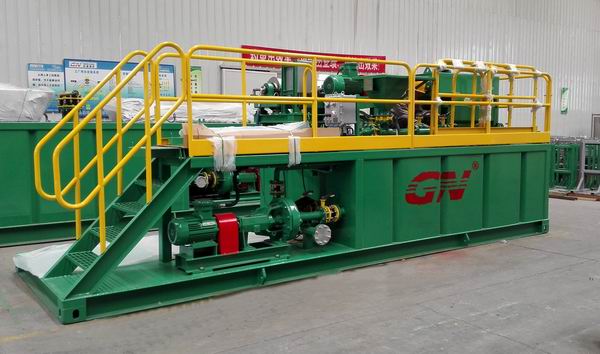
Absorbing experience from the systems we designed before, and our more and more knowledge on diamond drilling projects. Here is the solution.
Equipment: Like most of the solids removal units for diamond drilling, it contains a small shale shaker, small decanter centrifuge, centrifugal pump for feeding centrifuge & mixing, generator.
Here come two main features of this system:
1) One pump for two purposes. The centrifuge capacity is very small, and has to arrange a bypass pipe to return the extra fluids. While we have a pump for mixing, then why not deduct one and make them together.
2) All in ONE. the generator also can be a built in product. As for most of the diamond drilling projects, the rig is hydraulic, and people like hydraulic, as it is simple for the hydraulic experts. While there is not so many hydraulic shaker motor suppliers, especially such small ones.
What you can get from this system:
- Save your cost: there are many ways saving cost, combine two pumps to be one, change screens properly, then when centrifuges shut down, the system still working
- Nonstop working: though we move often, we do not want breaks because of the centrifuges, shakers can be widely used.
- Self-contained generator saves a lot of trouble, pls do not ask me for power supply, and prepare it!
Kindly contact with GN Solids Control if you are interested in.
- Details
-
Published: 16 July 2015
One more project for CNPC, as well known for good quality & rich experienced & higher standard research development ability, now GN waste management system is widely used in China oil field market.
This is a typical water based mud (WBM) waste management system, as in China, CNPC or whichever the big player, WBM is the most popular choice, collect the drilling waste from solids control system shale shaker, to two Hi-G dryer shakers, the G force up to 8.0. Then to the centrifuge for better separation, collect the useful drilling fluids, and get the waste solids out.
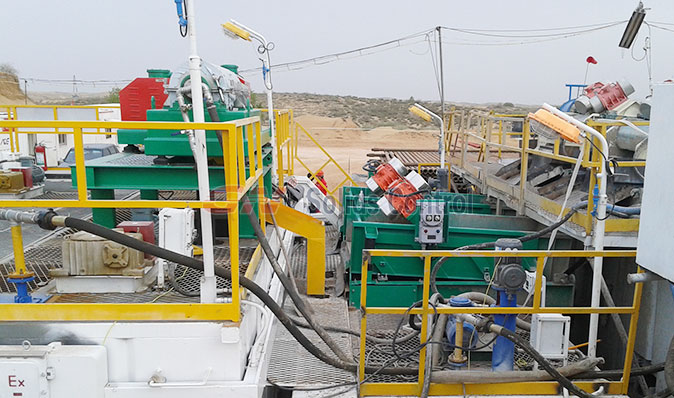
Normally the waste management system design must follow the origin design of the rig layout and solids control system. If properly designed, as this video, http://gnsolidscontrol.com/video/gn-high-g-drying-shaker-and-centrifuge-for-cnpc-wbm-waste-management, a lower tank can be arranged to collect the liquids treated by High G shaker, then it saves the delivery unit. Some clients dig a pit to place the vertical cuttings dryer, to make everything arranged properly on site.
Process of the close loop WBM drilling
This is well known, and widely used, almost a common sense for drilling operations. Even for the countries which are not so strict on environment protection, this is a must, as it actually saving drilling cost. Normally consist of shale shakers, mud cleaners and sometimes centrifuges.
2. Waste Management
GN Solids Control has designed several modular products for drilling waste management. The first one is delivery unit, which collects the waste solids from shale shaker to High G shaker, or vertical cuttings dryer. Then first step of drying, High G shaker, or vertical cuttings dryer; then the liquid go to next stage, High Speed decanter centrifuge.
The solids can be dumped after the solidification unit or TDU, which need to be collected from the dryer shaker, or vertical cuttings dryer; the liquid will be treated by centrifuge, or with a dewatering unit adding chemicals. Then finally reused or dumped to the environment.
- Details
-
Published: 10 July 2015
As China leading manufacturer on drilling waste decanter centrifuge and vertical cuttings dryer, GN Solids Control owns a big market share and good reputation. GN is the No. 1 Solids control manufacturer for direct exporting to international market.
Recently, GN dispatched 6 sets high speed drilling waste decanter centrifuge and 40 ea mud agitator for a South America customer.
Details of the 6 sets decanter centrifuge
Model: GNLW363CG-VFD
It is GN advanced design especially suits for drilling waste management field. All material choose from famous brand and top ranking standard. To enable a longer lifetime and less maintenance.
With GN patent design, the centrifuge can suits for more kind of bad condition jobsite.
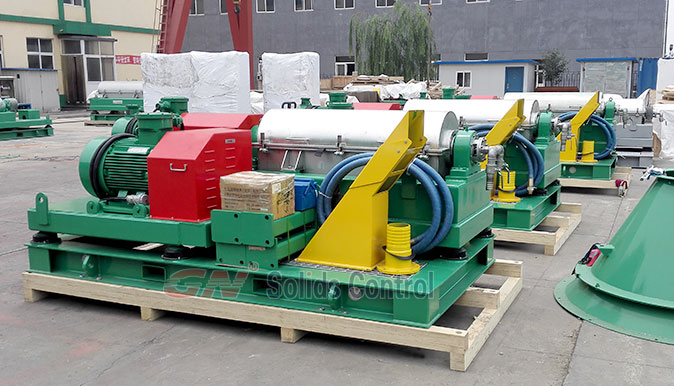
Applications of the GNLW363CG-VFD centrifuge
Firstly, it is more than enough to be used as solids control centrifuge.
Secondly, the centrifuge can be used for drilling waste management, to treat oil based mud, water based mud and synthetic mud.
Furthermore, the centrifuge can be used for waste water treatment and oily sludge separation. In these applications, the centrifuge is normally used together with chemical enhancing system.
For oil base mud, high speed centrifuge is normally used after vertical cuttings dryer. There will be small storage tank between vertical cuttings dryer and decanter centrifuge. The tank is used to stock fluids from vertical cuttings dryer, and a pump will be used to transfer the mud and feed for centrifuge. The stock tank should be equipped with a mud agitator to avoid solids settle down.
As the fluids from vertical cuttings dryer sometime is high solids content, if there is without agitator, the big solids will settle down very soon. Centrifuge feed pump normally suction from bottom of the tank, if there are too much sediment, the pump cannot suck mud and will be stopped as over current for self protection.
And with the chance of high request and standard on drilling waste decanter centrifuge, GN Solids Control got the opportunity to develop more business in China. GN supplied many drilling waste decanter centrifuge, vertical cuttings dryer and high G drying shaker to the 3 huge Government owned oil companies: SINOPEC, CNPC and COSL.
- Details
-
Published: 19 June 2015
Drilling waste management system becomes a more and more important part of drilling rig mud system. Without it the rig is not permitted to start. But as the cost of drilling waste equipment and system is higher, rig site do not want to spent cost and wait for long time to get the system. To cater for the customers’ request, China leading supplier, GN Solids Control makes standard drilling waste management equipment modular. With the separate modular parts, customer is easy to match a complete system per their jobsite request and rig condition.
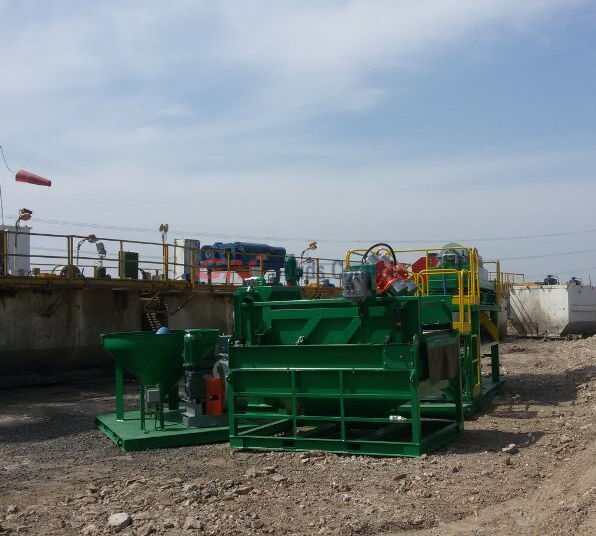
Last week, GN Solids Control dispatched a complete drilling waste management system to CNPC jobsite to treat their water base mud cuttings (OBM cuttings). The system is a turnkey solution including following modulars:
Part 1: 1 sets High G dryer shale shaker GNZS594HGE-LD with a under flow catch tank for direct use and fast movement. The HG drying shaker is mainly used to treat the water based drilling cuttings discharged from solids control shale shaker, desander and desilter.
Part 2: Drilling waste decanter centrifuge, with telescopic skid, guardrails, ladders feeding pump, piepelines, and other necessary accessories. The centrifuge is high speed with variable frequency control (VFD). It is easy to change the bowl speed, conveyor speed and pump speed in order get a better performance.
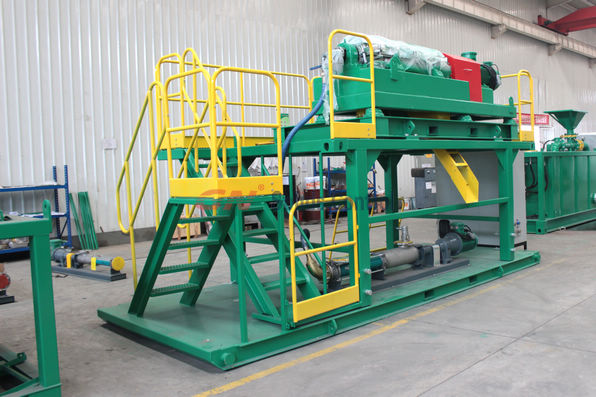
For the 14’’ hot sale high speed Decanter centrifuge, GN offer 2 standard of option:
Option 1: it is economic standard with economic standard material and common VFD control without PLC for smart control.
Option 2: it is widely chosed for international market. It is made per international higher standard to suit for more bad working condition. And the VFD control panel is positive pressurized with PLC for smart control.
The above decanter centrifuge and drying shale shaker is the main machine for water base mud drilling cuttings treatment. GN offer other transfer pumps, and cuttings box per customers’ request to make a complete system.
Welcome you contact GN and tell GN your jobsite condition to get a customized fast solution.
- Details
-
Published: 06 June 2015
Normally, Decanter centrifuge supplier will give a max. hydraulic capacity to show the centrifuge capacity, like 30 m3/h or 40 m3/h. For professional centrifuge user, they what that this parameter really means. But for some new users of centrifuge, it may cause some confusion.
To understand well this question, we should know what is max. with hydraulic test means.

Definition of centrifuge max. capacity:
It is the test figure from hydraulic test. It means the max. hydraulic input volume of the centrifuge can allow. All the input water can be pushed out by centrifuge and there will not be water came out from solids end.
Test method of centrifuge max. hydraulic capacity:
Close the bypass if there is. For fixed speed centrifuge, start centrifuge directly. For VFD centrifuge, Let it runs at the max. bowl speed and conveyer speed. And increase the water input step by step and make sure there is no liquid discharged from the solids end. If there is water out from solids end, it means it is overload. So small reduce it. The max. figure that water will not discharged from solids end is the max. capacity or max. hydraulic capacity of decanter centrifuge.
Many new centrifuge users are wondering: why our solids control centrifuge can treat mud 20m3/h, while the drilling waste management decanter centrifuge can only treat 10m3/h? And the drilling waste management centrifuge is high standard than solids control centrifuge? To understanding this question, we should know the definition of max. solids discharge rate first.
Besides max. hydraulic capacity, there is another figure beeb used together to definite centrifuge performance, it is called the max. solids discharge rate.
Definition of max. solids discharge rate
It means the max. solids a centrifuge can discharged per hour. It is from mud test.
Let’s say, if a centrifuge can treat max. 30m3/h mud with 10% solids content. It means the max. solids discharge rate is 3m3/h.
It means in any cases, the centrifuge can discharge solids no more than 3m3 mud per hour.
So the higher of the solids content, the smaller of the mud input (mud capacity).
If the solids content is 15%, the max. mud input should be less than 20cbm per hour. And for VFD centrifuge, in order to get better separation result, the bowl speed and conveyor speed should be adjust accordingly. For the same mud input with the same decanter centrifuge, the better of the separation, the smaller of mud capacity.
- Details
-
Published: 24 May 2015
GN Solids Control is China leading manufacturer on drilling mud solids control and drilling waste management system / equipment. With its advanced design and internal high standard quality, GN developed fast and got a worldwide reputation on solids control and drilling waste management supplier field.
As the normal comer of Houston OTC oil show, GN Solids Control came together with GN Solids America this year 2015.
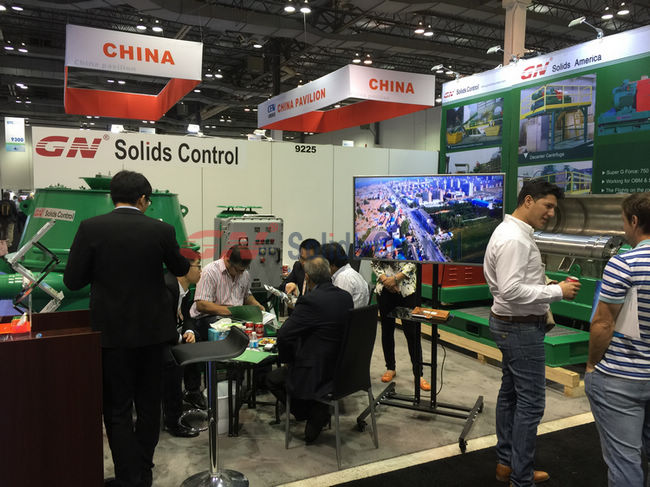
What equipment GN take for the show in Houston OTC 2015
1) Vertical cuttings dryer for OBM, WBM and SBM, model GNCD730A
Normally speaking, for other brand vertical cuttings dryer, they can only treat oil base mud and synthetic base mud. While GN patent design vertical cuttings dryer can be used to treat water base mud as well.
For many oil and gas drilling activities, like in Russia, Africa, U.S.A., European and Middle east, they use water base mud as the first stage or drilling. And then, they shift to oil base mud for deep drilling. In the traditional way for drilling waste management, they should use a high G shaker system to treat the oil base drilling cuttings, and then change to use vertical cuttings dryer system for oil base mud drilling cuttings treatment.
Now with GN advanced design vertical cuttings dryer system, the drilling jobsite can use the same one system for the whole drilling activities. They do not need to shift system during drilling. It can save drilling cost and time.
The model GN takes for the show is a small size high speed suitable for offshore drilling. As many customer told GN their jobsite is very limited on space and they need very compact design dryer for their site. Based on their conditions, GN designed the small size dryer with high speed an reach up to 1500rpm
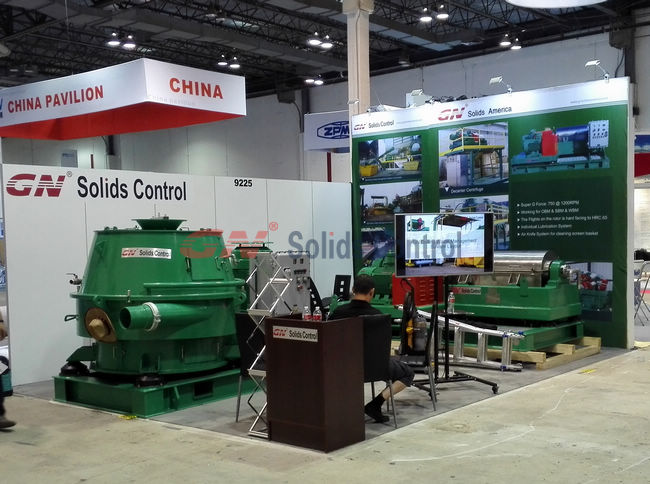
2) Another equipment GN takes for the show is high speed decanter centrifuge GNLW363C.
It is the most popular size centrifuge. With GN advanced design, it can be used for mud solids control, drilling waste management, waste water treatment, oily sludge separation and other fine solids separation applications.
If you have interest on GN drilling waste management equipment and want for more information, welcome you contact Gn group freely.
- Details
-
Published: 09 May 2015